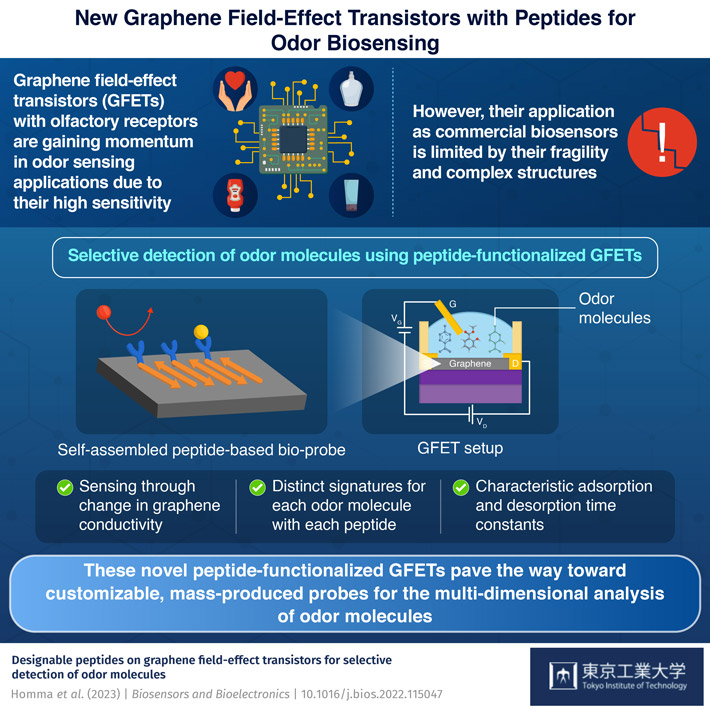Published: January 19, 2023
Graphene-based olfactory sensors that can detect odor molecules based on the design of peptide sequences were recently demonstrated by researchers at Tokyo Tech. The findings indicated that graphene field-effect transistors (GFETs) functionalized with designable peptides can be used to develop electronic devices that mimic olfactory receptors and emulate the sense of smell by selectively detecting odor molecules.

Olfactory sensing or odor sensing is an integral part of many industries including healthcare, food, cosmetics, and environmental monitoring. At present, the most commonly used technique for detecting and estimating odor molecules is gas chromatography–mass spectrometry (GC–MS). Though very effective, GC–MS has some limitations, such as its bulky setup and limited sensitivity. As a consequence, scientists have been looking for more sensitive and easy-to-use alternatives.
In recent years, graphene field-effect transistors (GFETs) have begun being used to develop highly sensitive and selective odor sensors by integrating with olfactory receptors, also known as electronic noses. The atomically flat surfaces and high electron mobility of graphene surfaces make GFETs ideal for adsorbing odor molecules. However, the application of GFET as electrical biosensors with the receptors is severely limited by factors, such as the fragility of receptors and the lack of altanative synthetic molecules that can function as olfactory receptors.
A team of researchers from Tokyo Institute of Technology (Tokyo Tech) led by Prof. Yuhei Hayamizu set out to address these issues with GFET-based olfactory receptors. In their recent study published in Biosensors and Bioelectronics, the team designed and developed three new peptides for graphene biosensors that can detect odor molecules. Prof. Hayamizu explains "The sequence of peptides we designed needed to perform two main functions—acting as a biomolecular scaffold for self-assembly on a graphene surface and functioning as a bio-probe to bind the odor molecules. This would allow the peptides to cover the graphene surface in a self-assembling manner and functionalize the surface uniformly to capture odor molecules."
The team carried out atomic force microscopy which showed that the peptides uniformly covered the graphene surface with the thickness of a single molecule. The functionalized graphene was then used to build a GFET setup for detecting odor molecules. After the assembly, the team injected limonene, menthol, and methyl salicylate as representative odor molecules into the GFET. The electrochemical measurements indicated that binding with the odor molecules reduced the conductivity of the graphene. The observations also revealed that the interaction between the three peptide sequences and the odor molecule gave rise to very distinct signatures. This confirmed that the GFET's response to the odor molecules depended on the peptide design.
Furthermore, the team carried out real-time electrical measurements to monitor the kinetic response of the GFET. The observations indicated that the time constraint associated with the adsorption and desorption of odor molecules was unique for each of the peptide sequences. This behavior was further confirmed by principal component analysis. These observations confirmed that the new GFET setup was successful in electrically detecting the odor molecules with the help of the designed peptides.
"Our approach is simple and can be scaled up for mass production of peptide-based olfactory receptors that can mimic and miniaturize the natural protein receptors responsible for our sense of smell. We are a step closer to realizing the concept of electronic noses," says Prof. Hayamizu.
The robust approach presented in this study opens new doors for the development of highly selective and sensitive GFET-based odor-sensing systems. These insights can also be put to use when designing advanced peptide sensors that can carry out multi-dimensional analysis of a range of odor molecules.
Reference
Authors :
Chishu Homma1, Mirano Tsukiiwa1, Hironaga Noguchi1, Masayoshi Tanaka2, Mina Okochi2, Hideyuki Tomizawa3, Yoshiaki Sugizaki3, Atsunobu Isobayashi3, *Yuhei Hayamizu1
Title :
Designable peptides on graphene field-effect transistors for selective detection of odor molecules
Journal :
Biosensors and Bioelectronics
DOI :
Affiliations :
1Department of Materials Science and Engineering, School of Materials and Chemical Technology, Tokyo Institute of Technology, Japan 2Department of Chemical Science and Engineering, School of Materials and Chemical Technology, Tokyo Institute of Technology, Japan 3Corporate Research & Development Center, Toshiba Corporation, Japan
* Corresponding author's email: hayamizu.y.aa@m.titech.ac.jp

